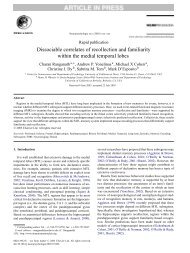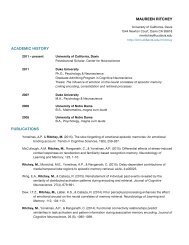CLINICAL EEG and NEUROSCIENCE - Dynamic Memory Lab
CLINICAL EEG and NEUROSCIENCE - Dynamic Memory Lab
CLINICAL EEG and NEUROSCIENCE - Dynamic Memory Lab
You also want an ePaper? Increase the reach of your titles
YUMPU automatically turns print PDFs into web optimized ePapers that Google loves.
<strong>CLINICAL</strong> <strong>EEG</strong> <strong>and</strong> <strong>NEUROSCIENCE</strong> ©2007 VOL. 38 NO. 1sense figures were repeatedly presented among othernon-recurring designs. 6 In this task, right temporal lobectomypatients showed marked difficulties in learning to distinguishbetween recurrent <strong>and</strong> non-recurrent nonsense patterns.Lateralized material-specific memory deficits werealso found in pre- or non-surgical TLE patients, eventhough in this group the pattern of double-dissociation wasless striking. 14These results had strong implications for clinical neuropsychologicalstudies aiming to lateralize or even localizethe epileptogenic focus, <strong>and</strong> many experiments wereperformed to replicate <strong>and</strong> further investigate this model.H o w e v e r, while it proved to be successful <strong>and</strong> reliable forverbal memory, the original findings were not always replicatedfor visual memory for which conflicting results werereported: Some studies, mainly with post-operative T L Epatients, confirmed the right temporal lobe superiority forvisual memory, but many others failed to find it. Over thelast 30 years, several studies have tried to identify factorsthat may explain these inconsistencies thus elaboratingthe original model. Especially, some variables concerningmaterials <strong>and</strong> tasks, different temporal lobe substructuresinvolved in memory processes, <strong>and</strong> patient characteristicswere found to influence the pattern of lateralization forvisual memory.Toward a Multifactorial ModelMultiple visual memory processesThe coarse distinction between verbal <strong>and</strong> visual memorymay not suffice to explain visual memory deficits inTLE. In fact, these may be caused by impairments of differentsubprocesses like encoding/learning, consolidation, orretrieval. Converging evidence indicates that these subprocessesthemselves may be lateralized differentially.Depending on the tasks used <strong>and</strong> the specific aspects ofvisual memory that these tasks tapped, different patternsof lateralization have been found. According to Barr, 7 thesetasks can be grouped into two main classes: Figural reproductiontests <strong>and</strong> figural learning tests.Both scientific experiments <strong>and</strong> routine clinical studiesperformed in epilepsy centers usually apply figural reproductiontests. These comprise a copy or immediate reproductionof some visual pictures followed by a seconddelayed reproduction, as in the Rey Osterrieth ComplexFigure (ROCF), Benton Visual Retention test (BVRT ) ,Visual Reproduction subtest from the Wechsler <strong>Memory</strong>Scale (WMS-VR) <strong>and</strong> from the Wechsler <strong>Memory</strong> Scale-Revised (VR-WMS-R), the Family Pictures <strong>and</strong> the supplementaltest of visual reproduction from the most recentWechsler <strong>Memory</strong> Scale Third Edition (WMS-III). By contrast,figural learning tests include a learning phase, inwhich a supraspan set of visual stimuli is to be recognisedor recalled over repeated trials, <strong>and</strong> a subsequent delayed(after 30-40 minutes) recognition or recall phase. Most frequentlyused are the abstract design list (ADL) learning <strong>and</strong>recall paradigm introduced by Jones-Gotman 15 <strong>and</strong> st<strong>and</strong>ardizedtests as the revised versions of the Diagnosticumfür Cerebralschädigungen (DCS-R; revised diagnostic testsfor cerebral lesions), the Rey’s Visual Design Test (RV D T ),<strong>and</strong> the Visual-Spatial Learning Test (VSLT ).Compared to figural reproduction tests, visual learning<strong>and</strong> memory tasks appear to be more sensitive to effectsof right temporal lobe lesions, especially with respect todelayed retention, in both post-operative 16-18 <strong>and</strong> pre-operativepatients 19-23 (but see 24 ). In one of the first studies,Helmstaedter et al 19 found impaired immediate recall,learning capacity <strong>and</strong> mean visual learning performance inpre-surgical patients with right as compared to left TLE.Similarly, Jones-Gotman et al 18 found that right temporallobectomy patients were impaired in visual learning, ascompared to controls, while no significant differencesbetween the groups were found in the retention (delayedrecall) of visual information.By contrast, less consistent <strong>and</strong> mostly negative resultson laterality effects have been found in studies using figuralreproduction tests: Only few studies reported significantd i fferences in the delayed reproduction performance ofROCF <strong>and</strong> VR-WMS-R between both pre- <strong>and</strong> post-surgicalpatients with right or left TLE (e.g. 25 - 27 ). Other studies didnot find any deficits in figural reproduction in right (or left)T L E . 28 - 30 R e c e n t l y, Barr et al 31 also reported negative findingsin a multicenter study with 757 epilepsy surgery c<strong>and</strong>idatesfrom 8 epilepsy centers, in which both ROCF <strong>and</strong> VR-WMS were applied. The few studies that examined the visualmemory subtests of the most recent Wechsler <strong>Memory</strong>Scale, III Edition reported conflicting findings. 32 , 33According to Barr, the lack of laterality effects reportedin most studies using figural reproduction tests may, atleast in part, be due to some confounding variables. 31Visual stimuli of some figural reproduction tests can easilybe encoded verbally (e.g., stimuli of VS-WMS-R, FamilyPictures of WMS-III), thus making compensatory verbalizationstrategies possible <strong>and</strong> therefore questioning the exactnature of the memory processes measured by the task.Moreover, reproduction requires intact motor <strong>and</strong> higherlevelconstructional abilities, so that impairments in eitherof these functions could confound the results.Unfortunately, not all studies on visual memory have controlledfor these functions.Although at present researchers <strong>and</strong> clinicians are stillsearching for “psychometrically sound <strong>and</strong> clinically usefulmeasures that are sensitive to material specific deficits,particularly visual memory processing,” 34 these studiesindicate some of the requirements that a test should haveto assess memory functions associated with the right temporallobe: It should include a learning phase in addition toan immediate <strong>and</strong> delayed recall or recognition phase, <strong>and</strong>it should be carefully constructed to avoid effects of confoundingvariables. Unfortunately, many clinical tests used19




